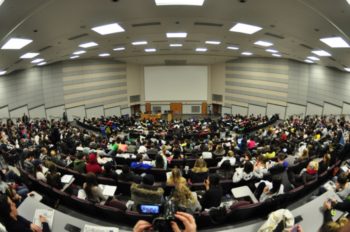
To properly evaluate and choose the right colleges for you, we must understand the traits of the different pools of colleges in the U.S. College education is not a widget that is exactly the same at every college or university, even when comparing the same major at two or more schools. Different types of colleges have different missions, different size/scale, varying availability of professor interaction, and varied pedagogical methods.
Public research universities with 25,000-65,000 undergraduate students (UT-Austin, A&M, UCLA, U of Alabama, etc.) offer large (200 or more students), mostly lecture oriented classes, with discussion-based courses available only to upper division students, if at all.
Smaller private colleges with approximately 2,000 students, sometimes called liberal arts colleges or teaching universities (Trinity TX, Amherst, Williams, Pomona), typically offer nearly all courses in discussion-based settings, with a small number of lecture courses. Nearly all classes are 25 or less, with many classes of 10-15 students.
Medium sized universities, typically private with 5-10,000 undergrads (Ivies, Stanford, SMU, TCU, Tulane, Vanderbilt), with some larger 10-20k undergraduates (USC, NYU, BU, Baylor), vary in the kinds of teaching styles and settings on offer. Some do a great job in limiting large lecture classes and mandating professor support for undergrads, many do not.
Penn and other Ivies have lots of lecture classes that have 100 or more students and professors who are not so available as hoped for. First and second year courses at UCLA, UT-Austin, Texas A&M, LSU, and many flagship public universities usually have 200 students or more. Faculty to student ratios at these and other universities are misleading!
We have had dozens students come to us in the last decade after a semester or two of personal and academic struggle at UCLA, UT-Austin, Texas A&M, LSU, and many other flagship public universities. In nearly every case, the students remarked that the biggest obstacle to their success was the overwhelming size and scale of the university.
These students were surprised that all of their classes were large lectures of 300-plus students with professors who were not helpful. Their families, high school staff, and teachers had not advised them (obviously they had not worked with us on college admission) that these universities were massive in scale and could prove difficult to navigate.
Many other uninformed students and families are surprised that Penn and other Ivies have lots of lecture classes that have 100 or more students and professors who are not so available as hoped for. BU, USC, and NYU and many other medium-sized private universities are notorious for offering 1st and 2nd year classes that have several hundred or more students like those found at public research universities.
